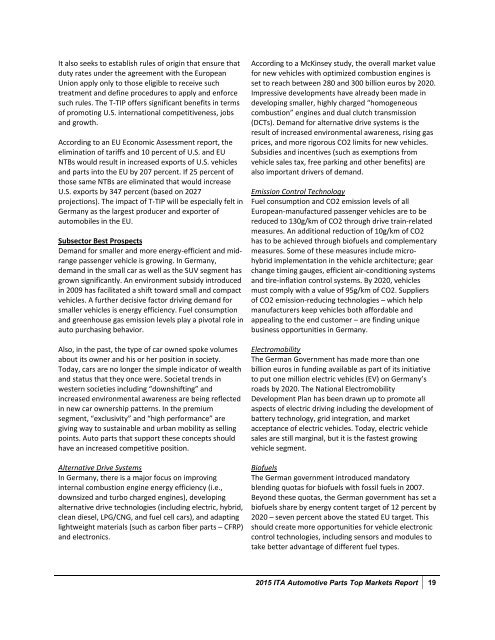Automotive Parts
Autoparts_Top_Markets_Report
Autoparts_Top_Markets_Report
Create successful ePaper yourself
Turn your PDF publications into a flip-book with our unique Google optimized e-Paper software.
It also seeks to establish rules of origin that ensure thatduty rates under the agreement with the EuropeanUnion apply only to those eligible to receive suchtreatment and define procedures to apply and enforcesuch rules. The T-TIP offers significant benefits in termsof promoting U.S. international competitiveness, jobsand growth.According to an EU Economic Assessment report, theelimination of tariffs and 10 percent of U.S. and EUNTBs would result in increased exports of U.S. vehiclesand parts into the EU by 207 percent. If 25 percent ofthose same NTBs are eliminated that would increaseU.S. exports by 347 percent (based on 2027projections). The impact of T-TIP will be especially felt inGermany as the largest producer and exporter ofautomobiles in the EU.Subsector Best ProspectsDemand for smaller and more energy-efficient and midrangepassenger vehicle is growing. In Germany,demand in the small car as well as the SUV segment hasgrown significantly. An environment subsidy introducedin 2009 has facilitated a shift toward small and compactvehicles. A further decisive factor driving demand forsmaller vehicles is energy efficiency. Fuel consumptionand greenhouse gas emission levels play a pivotal role inauto purchasing behavior.Also, in the past, the type of car owned spoke volumesabout its owner and his or her position in society.Today, cars are no longer the simple indicator of wealthand status that they once were. Societal trends inwestern societies including “downshifting” andincreased environmental awareness are being reflectedin new car ownership patterns. In the premiumsegment, “exclusivity” and “high performance” aregiving way to sustainable and urban mobility as sellingpoints. Auto parts that support these concepts shouldhave an increased competitive position.Alternative Drive SystemsIn Germany, there is a major focus on improvinginternal combustion engine energy efficiency (i.e.,downsized and turbo charged engines), developingalternative drive technologies (including electric, hybrid,clean diesel, LPG/CNG, and fuel cell cars), and adaptinglightweight materials (such as carbon fiber parts – CFRP)and electronics.According to a McKinsey study, the overall market valuefor new vehicles with optimized combustion engines isset to reach between 280 and 300 billion euros by 2020.Impressive developments have already been made indeveloping smaller, highly charged “homogeneouscombustion” engines and dual clutch transmission(DCTs). Demand for alternative drive systems is theresult of increased environmental awareness, rising gasprices, and more rigorous CO2 limits for new vehicles.Subsidies and incentives (such as exemptions fromvehicle sales tax, free parking and other benefits) arealso important drivers of demand.Emission Control TechnologyFuel consumption and CO2 emission levels of allEuropean-manufactured passenger vehicles are to bereduced to 130g/km of CO2 through drive train-relatedmeasures. An additional reduction of 10g/km of CO2has to be achieved through biofuels and complementarymeasures. Some of these measures include microhybridimplementation in the vehicle architecture; gearchange timing gauges, efficient air-conditioning systemsand tire-inflation control systems. By 2020, vehiclesmust comply with a value of 95g/km of CO2. Suppliersof CO2 emission-reducing technologies – which helpmanufacturers keep vehicles both affordable andappealing to the end customer – are finding uniquebusiness opportunities in Germany.ElectromobilityThe German Government has made more than onebillion euros in funding available as part of its initiativeto put one million electric vehicles (EV) on Germany’sroads by 2020. The National ElectromobilityDevelopment Plan has been drawn up to promote allaspects of electric driving including the development ofbattery technology, grid integration, and marketacceptance of electric vehicles. Today, electric vehiclesales are still marginal, but it is the fastest growingvehicle segment.BiofuelsThe German government introduced mandatoryblending quotas for biofuels with fossil fuels in 2007.Beyond these quotas, the German government has set abiofuels share by energy content target of 12 percent by2020 – seven percent above the stated EU target. Thisshould create more opportunities for vehicle electroniccontrol technologies, including sensors and modules totake better advantage of different fuel types.2015 ITA <strong>Automotive</strong> <strong>Parts</strong> Top Markets Report 19


